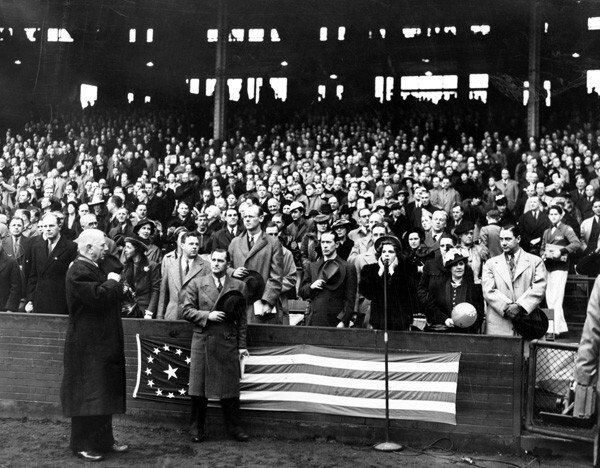Municipal Stadium

The demolition of Cleveland Municipal Stadium officially began in November 1996 and was complete by the following spring. In the fall of 1995, Cleveland Browns owner Art Modell decided to move the city's football team to Baltimore. Angry fans began the demolition process themselves during the Browns' final home game in 1995, tearing out seats and taking other pieces of Municipal Stadium with them as souvenirs, knowing it might be their last time in the stadium. Part of Mayor Michael White's deal with the National Football League to bring an expansion team to the city included the building of a new stadium. The old stadium would be torn down to make way for a new lakefront facility. Coincidentally, Cleveland's Osborn Engineering Company, which, along with architectural firm Walker and Weeks, had been the main designer of Municipal Stadium, oversaw the demolition of the stadium that it had so proudly helped build more than 65 years earlier.
The construction of Cleveland Municipal Stadium was completed in 1931. It had a seating capacity of slightly more than 78,000, which gave the stadium the largest outdoor seating capacity of any stadium in the world. In 1928, Cleveland voters approved a $2.5 million bond to help pay for its construction, one of the first instances in which the public helped finance a sports stadium. The final cost of construction came in at around $3 million. On July 3, 1931, the first event at the stadium was held when heavyweight boxing champion Max Schmeling defeated Young Stribling. This also marked the first time that a heavyweight boxing bout had taken place in Cleveland.
The Cleveland Indians played their first game at the stadium on July 31, 1932, and played all of the 1933 season there, as well. Until 1947, however, the team played its weekday games at the smaller League Park, opting to play at Municipal Stadium only during weekends and holidays when a larger crowd could be assured. In 1948 and 1954 the stadium hosted Major League Baseball's World Series.
The Cleveland Browns began playing at Municipal Stadium in 1946 when they were a part of the All-American Football Conference (AAFC) -- a short-lived rival to the NFL. The Browns won all four of the AAFC's title games, three of which ('46, '48, '49) were held in Municipal Stadium. The Browns also had a perfect regular season (14-0) in 1948 and won the AAFC championship at the stadium that year by defeating the Buffalo Bills, 49-7.
After moving to the NFL in 1950, the team continued their success. The Browns played host to the NFL Championship Game (the precursor to the Super Bowl) in 1950, 1952, 1954, 1964, and 1968, winning each time except for the last. Today, the new Cleveland Browns Stadium (opened in 1999) sits on the site of Municipal Stadium.
Video
Audio
Images







